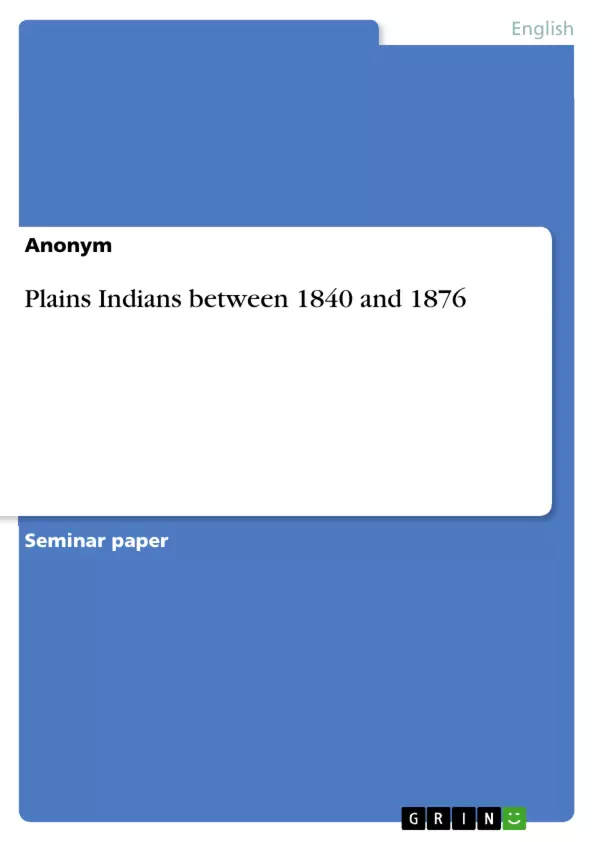The Plains Indians had a tough life. They were abandoned from their lands by white settlers over and over again. Losing their culture, losing their main food source, and losing many lives. They experienced hunger, racism and war and are now one of the most important icons of the American Culture.
When the Europeans first entered the Plains, they had a peaceful relationship, but with the American expansion, the Plains Indians lost many of their population and also their land and resources. Emigrants putting their bison away, Oregon trail taking land of the Plains Indians, diseases which they brought with them. A series of wars took place from the beginning of the European settlements until the late 19th century, known as the American Indian wars.
We will take a closer look on the things happening between 1840 and 1876.
Plains Indians: often imagined as the typical American Indians, riding on horseback with a feather and communicating in sign language, were the Native Americans living in the Great Plains of North America.
The Great Plains is a vast grassland spreading from Texas to the south of Canada, between the Mississippi River and the Rocky Mountains, covering almost 800km east to west and 4,800 km north to south. Its an incredible landscape with herds of buffaloes. (“Plains Indian”)
In 1778 Thomas Jefferson had the idea of exploring the Great West and later chose Lewis to do the expedition with. He sent the proposition to the congress who then approved it. Lewis chose William Clarke as an associate. However, the journals have a lack of information about the geography, anthropology and even more. Maybe because their expedition was largely made by water and rather by land. Zebulon M. Pike made the next expedition in July 15, 180 and took horses to not only see the water but more the landscape. People also started naming the Great Plains the Great American Desert, seeing the region as a desert because it was sparsely populated. It also was quite unexplored until not only Lewis and Clark, but also Pike went on an expedition. In fact, before that, Colonel Richard Irving once said in his book The Hunting Grounds of the Great West: ”when I was a schoolboy my map of the United States showed between the Missouri River and the Rocky Mountains a long and broad white blotch, upon which was printed in small capitals “THE GREAT AMERICAN DESERT – UNEXPLORED”. The expedition whetted the appetite to learn more about the land.
Inhaltsverzeichnis (Table of Contents)
- Introduction
- Tribes
- The Sioux
- The Cheyenne
- Culture and Religion
- The Indian problem
- The Indian wars
- The Dakota war
- The six-shooter
- Homestead Movement
- Sand Creek massacre
- Red Cloud war
- Red River war
Zielsetzung und Themenschwerpunkte (Objectives and Key Themes)
This text provides an overview of the experiences of the Plains Indians between 1840 and 1876, a period marked by significant conflict and displacement. It explores the impact of European settlement, the displacement of indigenous communities, and the resulting wars and cultural changes.
- The historical context of the Plains Indians and their traditional way of life
- The impact of European expansion and the "Indian problem" on Native American communities
- The various conflicts and wars that took place between the Plains Indians and the U.S. government
- The effects of displacement, loss of land, and cultural suppression on the Plains Indians
- The role of the U.S. government and its policies in shaping the fate of the Plains Indians
Zusammenfassung der Kapitel (Chapter Summaries)
- Introduction: This chapter introduces the Plains Indians, their traditional lifestyle, and the challenges they faced during the expansion of European settlers. It highlights the loss of land, culture, and lives, emphasizing the harsh realities they experienced.
- Tribes: This chapter introduces some of the prominent Plains Indian tribes, such as the Blackfoot, Arapaho, Cheyenne, Comanche, Crow, Kiowa, and Sioux. It provides brief accounts of their history, location, and current status.
- Culture and Religion: This chapter describes the cultural practices and religious beliefs of the Plains Indians. It explores their reliance on buffalo hunting, their use of tipis as dwellings, and their belief in the Great Spirit.
- The Indian problem: This chapter examines the challenges faced by the Plains Indians due to the westward expansion of European settlers. It explores the concept of the "Indian problem" as seen by the U.S. government and the various treaties, laws, and policies implemented to address it.
- The Indian wars: This chapter recounts various conflicts and wars between the Plains Indians and the U.S. government. It provides summaries of significant events such as the Dakota War, the six-shooter's impact on warfare, the Homestead Movement, the Sand Creek massacre, the Red Cloud War, and the Red River War.
Schlüsselwörter (Keywords)
This text focuses on the history of the Plains Indians, their culture, and their encounters with European settlers. Key terms include: Plains Indians, Native Americans, American expansion, Indian problem, treaties, displacement, cultural suppression, Indian wars, Dakota War, six-shooter, Homestead Movement, Sand Creek massacre, Red Cloud War, Red River War.
- Quote paper
- Anonym (Author), 2020, Plains Indians between 1840 and 1876, Munich, GRIN Verlag, https://www.grin.com/document/1421435



